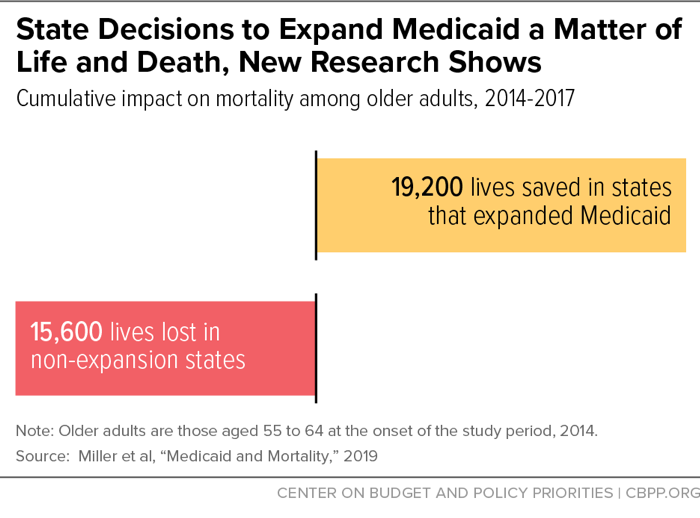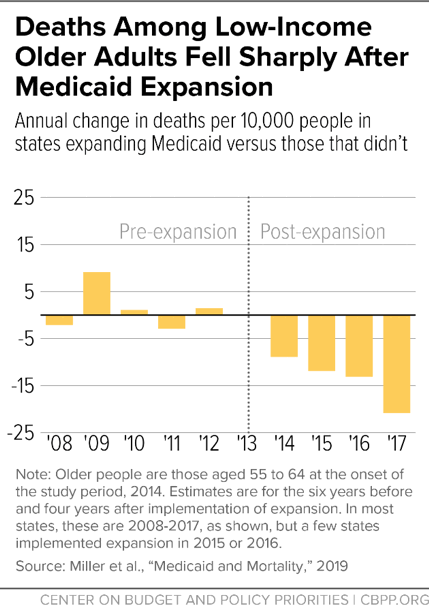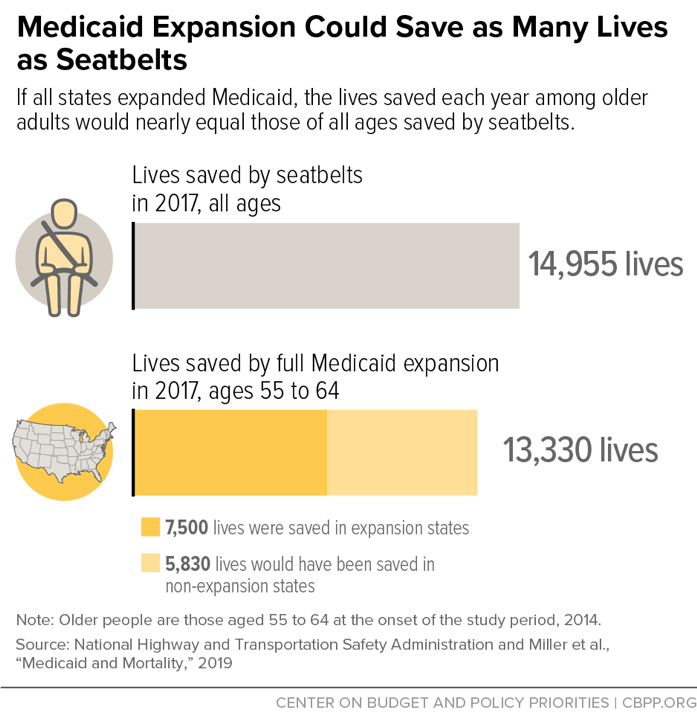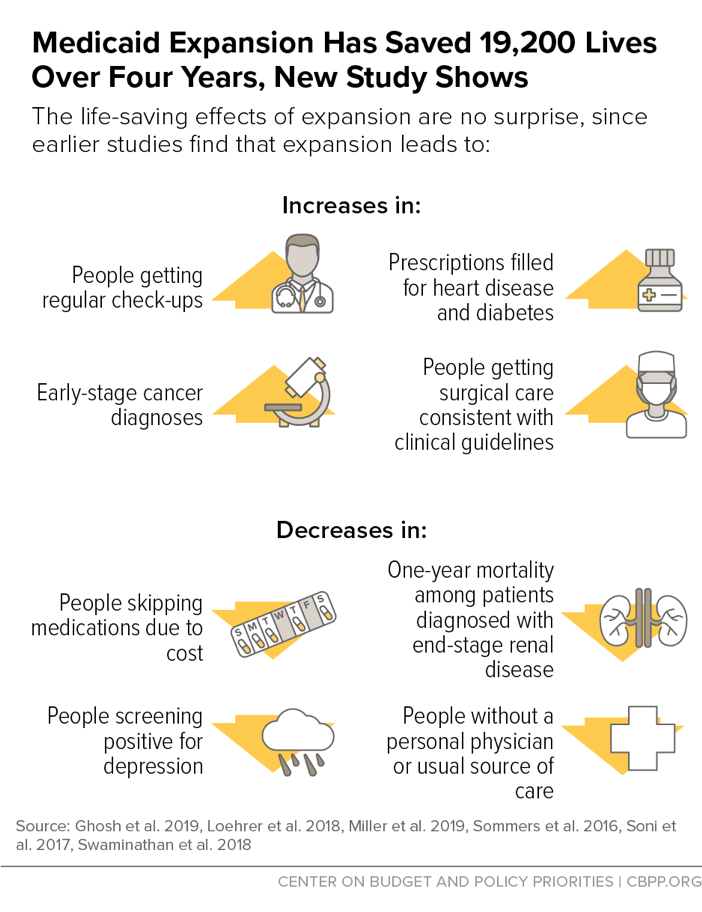Medicaid Expansion Has Saved at Least 19,000 Lives, New Research Finds
State Decisions Not to Expand Have Led to 15,000 Premature Deaths
End Notes
[1] Sarah Miller et al., “Medicaid and Mortality: New Evidence from Linked Survey and Administrative Data,” National Bureau of Economic Research working paper, August 2019, https://www.nber.org/papers/w26081.
[2] Larisa Antonisse et al., “The Effects of Medicaid Expansion under the ACA: Updated Findings from a Literature Review,” Kaiser Family Foundation, August 15, 2019, https://www.kff.org/medicaid/issue-brief/the-effects-of-medicaid-expansion-under-the-aca-updated-findings-from-a-literature-review-august-2019/.
[3] Centers for Medicare & Medicaid Services, “Speech: Remarks by Administrator Seema Verma at the National Association of Medicaid Directors (NAMD) 2017 Fall Conference,” November 7, 2017, https://www.cms.gov/newsroom/fact-sheets/speech-remarks-administrator-seema-verma-national-association-medicaid-directors-namd-2017-fall.
[4] The study sample population comprises those who were aged 55 to 64 in 2014, who either are in a household with income under 138 percent of the federal poverty line or have less than a high school education, who are citizens, and who do not receive Supplemental Security Income. These restrictions are intended to capture a population of older adults who are likely to benefit from Medicaid expansion.
[5] CBPP calculates a non-elderly mortality rate using mortality rate data by age group from the Centers for Disease Control and Prevention (CDC) weighted by population data by age group from the American Community Survey (ACS). The most recent available data are for 2017. Note that due to data limitations “non-elderly adults” here refers to those aged 15 to 64. For mortality rate data see Sherry Murphy et al., “Mortality in the United States, 2017,” Centers for Disease Control and Prevention, November 2018, https://www.cdc.gov/nchs/data/databriefs/db328-h.pdf.
[6] Estimates are for the six years before and four years after implementation of Medicaid expansion. In most states, the first year of expansion was 2014, but a few states implemented the policy in 2015 or 2016.
[7] These estimates are CBPP calculations based on the mortality impacts and sample sizes reported in the paper.
[8] CBPP calculations based on the Centers for Medicare & Medicaid Services’ (CMS) most recent Medicaid and CHIP Monthly Enrollment Report reflecting May 2019 enrollment, https://www.medicaid.gov/medicaid/program-information/medicaid-and-chip-enrollment-data/index.html. Excluded states are Delaware, Massachusetts, Washington, D.C., New York, and Vermont.
[9] National Highway Traffic Safety Administration, accessed August 2019, https://www.nhtsa.gov/risky-driving/seat-belts. See also National Highway Traffic Safety Commission, “Lives Saved Calculations for Seat Belts and Frontal Air Bags,” U.S. Department of Transportation, December 2009, https://crashstats.nhtsa.dot.gov/Api/Public/ViewPublication/811206.
[10] This estimate is larger than the estimated reduction in mortality for the study’s full sample of older adults because only about 15 percent of those in the expansion state sample gained coverage through expansion.
[11] CBPP calculation based on estimates from the Miller et al. study. The mortality rate for 55- to 64-year-olds under 138 percent of the federal poverty line (FPL) is 1.7 percent, as compared to 0.4 percent for 55- to 64-year-olds above 400 percent FPL, according to data from the National Center for Health Statistics that is included in the study. The mortality rate for those above 400 percent FPL is roughly 76 percent lower. The poverty line is $16,910 for a family of two, and 400 percent of the poverty line is $67,640 for a family of two.
[12] Ausmita Ghosh, Kosali Simon, and Benjamin Sommers, “The Effect of Health Insurance on Prescription Drug Use Among Low-Income Adults: Evidence from Recent Medicaid Expansions,” Journal of Health Economics, Vol. 63, January 2019, https://www.sciencedirect.com/science/article/pii/S0167629617300206.
[13] Benjamin Sommers et al., “Changes in Utilization and Health Among Low-Income Adults After Medicaid Expansion or Expanded Private Insurance,” JAMA Internal Medicine, October 2016, https://jamanetwork.com/journals/jamainternalmedicine/fullarticle/2542420.
[14] Ibid.
[15] Ibid.
[16] Andrew P. Lohrer et al., “Association of the Affordable Care Act Medicaid Expansion with Access to and Quality of Care for Surgical Conditions,” JAMA Surgical Medicine, March 21, 2018, https://jamanetwork.com/journals/jamasurgery/fullarticle/2670459.
[17] Aparna Soni et al., “Effect of Medicaid Expansions of 2014 on Overall and Early-Stage Cancer Diagnoses,” American Journal of Public Health, February 2018, https://ajph.aphapublications.org/doi/abs/10.2105/AJPH.2017.304166; Ahmedin Jenal et al., “Changes in Insurance Coverage and Stage at Diagnosis Among Nonelderly Patients with Cancer After the Affordable Care Act,” Journal of Clinical Oncology, December 2017, https://ascopubs.org/doi/10.1200/JCO.2017.73.7817; and Emanuel Eguia et al., “Impact of the Affordable Care Act (ACA) Medicaid Expansion on Cancer Admissions and Surgeries,” Annals of Surgery, Vol. 268, No. 4, October 2018, https://journals.lww.com/annalsofsurgery/Abstract/2018/10000/Impact_of_the_Affordable_Care_Act__ACA__Medicaid.6.aspx.
[18] Swaminathan Aiyar et al., “Association of Medicaid Expansion with 1-Year Mortality Among Patients with End-Stage Renal Disease,” JAMA, December 4, 2018, https://www.ncbi.nlm.nih.gov/pubmed/30422251.
[19] Rebecca Myerson et al., “Medicaid Eligibility Expansions May Address Gaps In Access To Diabetes Medications,” Health Affairs, Vol. 37, No. 8, August 2018, https://www.healthaffairs.org/doi/full/10.1377/hlthaff.2018.0154; and Elbert Huang, James Meigs, and Daniel Singer, “The Effect of Interventions to Prevent Cardiovascular Disease in Patients with Type 2 Diabetes Mellitus,” American Journal of Medicine, Vol. 111, No. 8, December 2001, https://www.amjmed.com/article/S0002-9343(01)00978-0/fulltext.
[20] Benjamin Sommers, “State Medicaid Expansions and Mortality, Revisited: A Cost-Benefit Analysis,” American Journal of Health Economics, 2017, https://www.mitpressjournals.org/doi/pdf/10.1162/ajhe_a_00080. Note, this is a follow-up to an original Sommers, Katherine Baicker, and Arnold Epstein article published in the New England Journal of Medicine in September 2012. That study also found a 6.1 percent relative reduction in all-cause mortality equating to nearly 20 lives saved per 100,000 adults. The revised study improves upon the comparison group selection, and uses more detailed data on causes of death. CBPP calculates the estimate of fewer deaths by applying the Sommers study results to the total population of adults aged 20 to 64 living in Arizona, Maine, or New York in 2017.
[21] Benjamin Sommers, Sharon Long, and Katherine Baicker, “Changes in Mortality After Massachusetts Health Care Reform: A Quasi-experimental Study,” Annals of Internal Medicine, Vol. 160, No. 9, May 6, 2014, https://docs.house.gov/meetings/IF/IF02/20140507/102194/HHRG-113-IF02-20140507-SD006.pdf. CBPP calculates the estimate of fewer deaths by applying the Sommers study results to the total population of adults aged 20 to 64 living in Massachusetts in 2017.
[22] Amy Finkelstein et al., “The Oregon Health Insurance Experiment: Evidence from the First Year,” National Bureau of Economic Research Working Paper No. 17190, July 2011, https://www.nber.org/papers/w17190.
[23] Using population survey data, the authors determine the size of the population in each state that matches the study sample criteria and then uniformly apply the national-level mortality rate impact of Medicaid expansion to each state’s sample population. These estimates were released as a supplement to the main paper. Sarah Miller et al., “State Level Mortality Estimates Based on Miller et al. 2019 NBER Working Paper 26081,” National Bureau of Economic Research working paper, August 17, 2019, http://www-personal.umich.edu/~mille/ACAMortality_ByState.pdf.
[24] Center on Budget and Policy Priorities, “Chart Book: The Far-Reaching Benefits of the Affordable Care Act’s Medicaid Expansion,” October 2, 2018, https://www.cbpp.org/research/health/chart-book-the-far-reaching-benefits-of-the-affordable-care-acts-medicaid.





